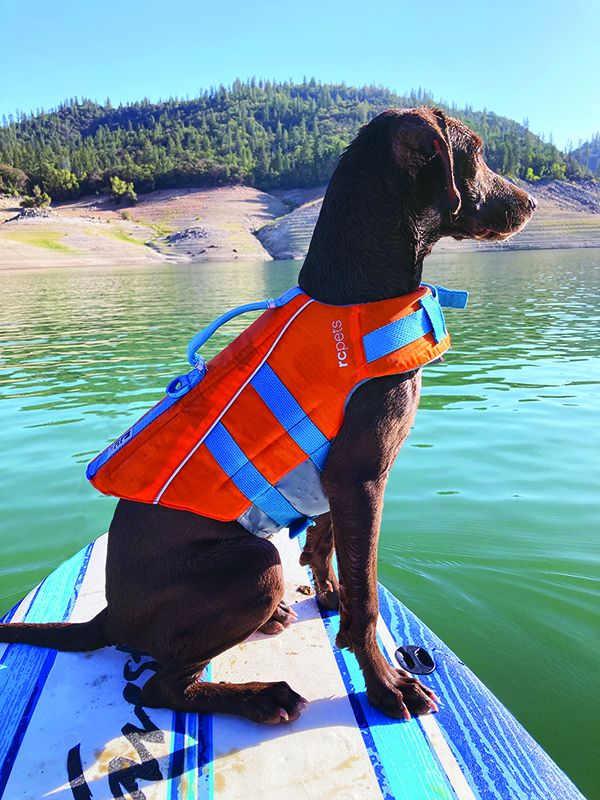Paddlesports have been a popular trend for the past several years, in large part due to the convenience and lowered costs of inflatables, but since the pandemic hit in 2020, the interest has skyrocketed as people seek outdoor recreational activities they can do close to home. Being able to go kayaking with your dog along for a paddle, or on a paddle board makes it even more appealing.
Paddling with a dog on board may look easy, but whether your outing is a success or a debacle depends on how well you understand and prepare for the risks and challenges. Consider these seven tips to help you enjoy the water safely with your dog while kayaking, paddleboarding, and more.
1. Paddle within your abilities
Paddling a canoe, kayak, or stand-up paddleboard can seem simple, and your excitement to get out onto the water with your furry friend could make you underestimate how difficult it can be. Weather and water conditions can quickly change, and you need to know what to do when things go wrong.
Make sure you have sufficient training and experience paddling your craft before you attempt it with a dog. Paddling with a dog on board will require more skill, strength, and stamina than paddling alone.
Depending on the size of your dog, you may have to expend a lot more energy to cope with added weight, wind resistance, sudden weight shifts, and helping your dog back onto the craft. Also, a dog can take your attention away from hazards or cause you to make unplanned stops along difficult shorelines.
2. Paddle within your dog’s abilities
What is the biggest challenge you face with your dog’s behaviors on a paddle craft? I posed this question in a social media group for people who paddle with dogs, and every response related to the dog being overstimulated by the environment or stressed by the experience. Their dogs were not able to relax and settle, and many had difficulty preventing their dogs from jumping into the water to swim, chase wildlife, or meet other paddlers nearby (and join them on their craft). Many dogs did not respond well to instructions, especially coming when called.
Don’t let your desire to bring along your dog interfere with your ability to accurately assess whether your dog will be a good passenger. A distracted dog can endanger himself, you, and others. Additionally, if you or your dog require rescue, these attempts may be hindered if your dog is fearful of, or aggressive toward, strangers.
You will need excellent verbal control of your dog in a high-distraction environment. Are you confident that your dog will be able perform a reliable recall in an environment that includes proximity to wildlife, a body of water, and objects that resemble toys (things floating in the water)? If you require a leash or other training/management tool to control your dog, then she’s not ready to come along on a paddle. (To prepare your dog, or test her preparation, try all the “Dry-Land Training” exercises.)
Is your dog physically capable of balancing on a boat or paddleboard? Your dog will require a fair amount of muscle strength and stamina to balance on the craft and get back on from the water. Water and weather conditions can put an additional strain on your dog.
Will your dog truly enjoy the experience and be able to settle? Stress – even “happy stress” – can make a dog more susceptible to dehydration, hypothermia, heat exhaustion/stroke, and shock, so you want to be skilled in reading your dog’s subtle stress signals to monitor your pet for early signs of distress and discomfort.
3. Learn first aid for dogs
The most obvious risk to your dog is drowning, so it is essential you know how to administer CPR and mouth-to-snout artificial respiration.
Perhaps less apparent but just as dangerous are the risks of dehydration, hypothermia, heat exhaustion/stroke, and shock, particularly for puppies, dogs who are elderly or in poor health, very small dogs, or brachycephalic breeds. You need to know what signs to watch for, how to provide emergency aid, and what not to do, such as cooling a dog too quickly.
4. Be aware of potential water hazards
Common water hazards include sharp debris along shorelines (shells, rocks, glass, fish hooks, etc.), contaminants (pollution, blue green algae), and large rocks, branches, or debris close to the surface. In some areas, the wildlife could be a danger to your dog, and some predators may try to snatch your dog out of the craft. A lesser-known but very real danger is water intoxication/salt water toxicity, especially if your dog likes to drink from bodies of water, bite at the water, or fetch in the water. Ingesting too much water is life-threatening, and the symptoms can be easily misdiagnosed or dismissed with deadly consequences to your dog.
5. Use a dog life jacket
Even if your dog is an excellent swimmer, a well-fitted dog life vest, appropriate for his weight, is essential for your dog’s safety as well your own – because a medium- to large-sized dog struggling to stay afloat can drown a person.
A life vest also provides some protection from the sun, rain, and cold, and it gives you something to grab onto if you need to help your dog back onto the craft. Many dog life vests have a handle on the top for this purpose. Be sure you spend time conditioning your dog to enjoy wearing the dog life vest before you try to use it on the water.
See Whole Dog Journal’s Dog Life Jacket Review.
6. Bring pet-safety essentials
What you decide to bring with you on the craft depends on how long you plan to be out on the water and how far you will be from your vehicle. Be sure to pack the items in a good-quality dry bag. You should have with you a bottle of fresh water for your dog (and a container for your dog to drink from). It is unwise to let your dog drink from the body of water, and a bottle of clean water can also be used to flush debris from a wound.
A dry towel for your dog can also be very useful as protection from the sun or cold, and a wet towel can help in cooling your dog gently (e.g., when treating heat exhaustion/heat stroke).
There may be a high risk of paw-pad injuries from debris along the shore line, so it’s a good idea to bring some self-adhesive bandage for rudimentary first-aid treatment until you can get your dog to the vet clinic. Dog booties might be an option for your dog, but ensure they do not interfere with your dog’s ability to balance or swim. You should also bring along emergency information such as the address and phone number of the nearest vet clinic and an emergency whistle, just in case.
For longer or more remote paddle trips, you will want to include more pet first-aid items such as (but not limited to):
• Small bottle of sterile saline solution to rinse debris from the eyes or a wound
• Extra bottle of clean water
• Disinfecting wipes
• Dog-safe antihistamine product for allergic reactions
• Peroxide to induce vomiting
• Emergency ration of your dog’s food in case you are stranded or delayed.
Here is our list of 12 items that are first aid kit essentials when traveling and doing activities with your dog.
7. Use a leash (but not on the water)
The shoreline may have sharp rocks, shells, broken glass, fishing hooks, etc., and using a leash to keep your dog near you until you board the craft can help reduce the chances of your dog injuring a paw. A leash may also be useful in emergency situations and unplanned stops, so be sure to bring it even if you don’t think your dog will need it.
Remove your dog’s leash once you are on the water, and safely stow it. A leash can become tangled in equipment and limbs (yours and the dog’s), and it can snag on objects if it drags in the water. Never tether your dog to the paddle craft, you, or any object because your dog could get tangled or dragged under the water and be unable to get loose. If your dog requires a leash to be well behaved on the water, then your dog is not ready yet to come along.






Great article! Well written and relevant.
At our state park lake, the regulations state that for state parks in Missouri, dogs must be leashed at all times. I took this as meaning on the water as well. He did okay in the canoe for his first adventure and would like to attempt to try SUP with him in the future. I agree that a leash while on water seems more dangerous for the tangle potential but don’t want to be in violation of rules.
Does anyone have experience with similar rules and does it only apply to land?
We have the same regulations about leashes. I attach pieces of pool noodle to my dog’s leash so it floats when she is swimming and easier to grab plus not tangle.
Very helpful! I’ve been eyeing kayaks for some time now, and want to take my retriever along. Thanks!